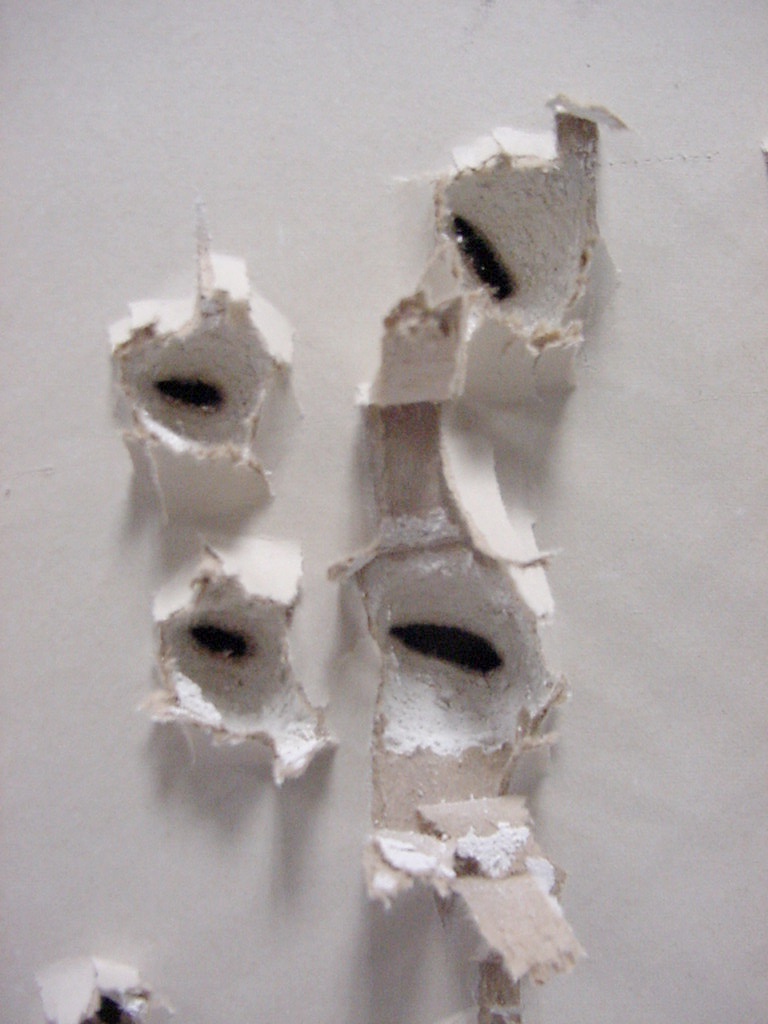A typical bullet, whether fired from a rifle or a pistol, will go through approximately 4 or 5 walls before stopping.
If you are taking cover from an armed aggressor, a simple interior house wall is not sufficient to hide behind.
If you are shooting defensively, you are responsible for every bullet fired. Know what is behind your target.
Does Drywall Stop Bullets? (No)
by Herb Schildt @ www.gunssavelife.com
For years I have wanted to know if normal drywall (as used in houses) would stop various caliber bullets. This is an important question because it affects how one judges and responds to the threat posed by an armed intruder.
For example, if an armed burglar invades your home, will a standard 2×4 framed, drywall covered wall protect you from bullets fired by this bad guy? In other words, can a bullet travel through a wall from one room to the next and still have enough energy to cause harm to yourself or another family member? Furthermore, if a round penetrated the wall, I wanted to know how much residual energy was left. Because it is the velocity of the bullet that makes it dangerous, it is not sufficient to know only that the wall was penetrated. The exit velocity of the round is needed.
I decided to conduct an experiment in which bullets of known velocities, calibers, and types were fired through a wall section that replicated the type of wall used in my house. I began by building a small section of wall consisting of 4 sheets of 5/8 inch drywall, each separated from the next by a 2×4. Thus, the section simulated two complete walls of drywall.
I decided to use two complete walls in order to gather as much information as possible with a single experiment. For example, if the first wall did not stop a round, would the second wall stop it? Because two are the maximum number of walls that I felt would be likely to be between family members and an armed intruder, this was an important question. Also, two complete wall sections would better record the effects of bullet deformation and tumbling as it passed through each sheet of drywall.
Once the wall section was finished, I fired various rounds from 15 feet away from the wall. I also measured the velocity of the bullets after they exited the drywall using a chronograph. The chronograph was positioned approximately 3 feet past the wall section.
I shot three calibers: .223, 9mm, and .45. I chose these for two reasons. First, they are very common calibers. Second, they represent a wide spectrum. As most readers will know, .223 is a high-velocity rifle round, 9mm is a reasonably quick pistol round, and .45 is a relatively slow pistol caliber.
I began with.223 rounds, starting at the top of the wall section. Next, I fired 9mm into the middle of the wall, followed by .45 on the bottom. I finished by measuring the unobstructed muzzle velocity of the various rounds. Frankly, the results were surprising. (See photo.) The outcomes are shown in the following table.
As the table shows, every round penetrated four layers of drywall, retaining a substantial amount of its initial velocity. It appears that when impacted by an object traveling at a high rate of speed, drywall is brittle, giving way rather easily. Thus, little bullet energy is lost punching a hole through it. Frankly, it does not appear that normal drywall offers significant protection against an armed intruder.
Caliber .223, 55 gr FMJ (Winchester USA) 9mm FMJ (Winchester) 9mm HP
(Win. Supreme SXT).45 FMJ
(Winchester bullets reloaded ammo)
Note the "keyholing" of .223 rounds. As a point of interest, if you examine the .223 exit holes, you can see the “key-hole” pattern caused by the bullet beginning to tumble upon impact with the first wall. The 55 grain, .223 bullet is designed to tumble upon impact and this is why it is effective.It is necessary to state these disclaimers:
Nevertheless, the exit holes in the drywall section prove that all bullets retained a substantial amount of residual energy.
- These results represent one data point, on one day. Different guns, ammo, bullet shapes, or calibers may (probably will) give different results.
- Each shot was fired straight-on into the wall. I don’t know what effect angled shots would produce.
- No bullets were fired through the 2×4 studs, which would significantly reduce bullet velocity.
- Chronographs are finicky devices and subject to some variations. It is possible that the readings were off by a percent or two.
http://www.gunssavelife.com/?p=3162

No comments:
Post a Comment